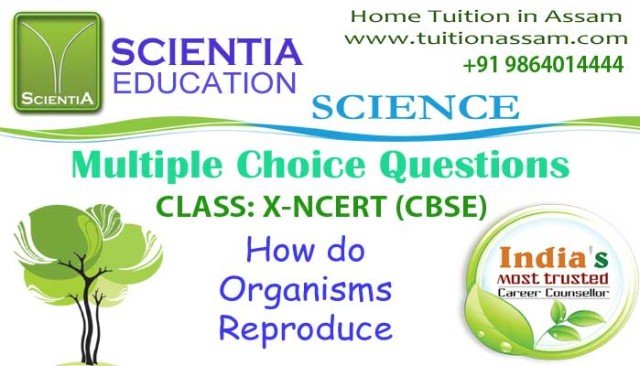
CLASS: X NCERT (CBSE)
BIOLOGY
How do Organisms Reproduce
Question 1: The male hormone testesterone is produced by _________.
1. Leydig cells
2. Seminiferous tubules
3. Epididymis
4. Vas deferens
Answer: 1
Question 2: Male gonads are called _______________.
1. testes
2. ovaries
3. scrotal sacs
4. sperm duct
Answer: 1
Question 3: The fertilized egg is called ______________.
1. ovum
2. blastocyst
3. diploid cell
4. zygote
Answer: 4
Question 4: The ultimate stoppage of menstrual cycle is called _______.
1. puberty
2. menarche
3. menopause
4. old age
Answer: 3
Question 5: The process by which the sperms are produced is known as ____________.
1. ovulation
2. spermatogenesis
3. oogenesis
4. gestation
Answer: 2
Question 6: The tube that carries the sperms out of the testes is the __________________.
1. vasa efferentia
2. vas deferens
3. oviduct
4. epididymis
Answer: 2
Question 7: The process by which the sperms are released is called __________________.
1. spermatogenesis
2. oogenesis
3. ovulation
4. ejaculation
Answer: 4
Question 8: The external genitalia in females is called ____________.
1. pubis
2. vagina
3. vulva
4. clitoris
Answer: 3
Question 9: Sterilisation in males is called as _____________.
1. tubectomy
2. vasectomy
3. IVF
4. GIFT
Answer: 2
Question 10: Binary fission is seen in __________________.
1. plasmodium
2. hydra
3. amoeba
4. mucor
Answer: 3
Question 11: The endosperm nucleus is _______________.
1. haploid
2. diploid
3. triploid
4. tetraploid
Answer: 3
Question 12: The fertilization of human egg by the sperms takes place in __________________.
1. ovary
2. oviduct
3. vagina
4. uterus
Answer: 2
Question 13: Pollen tube contains _____________.
1. one male nucleus
2. two male nuclei
3. three male nuclei
4. four male nuclei
Answer: 2
Question 14: If the pollen is transferred to the stigma of the same flower, it is called __________.
1. allogamy
2. autogamy
3. cross pollination
4. double fertilization
Answer: 2
Question 15: Pollen grains are produced by ________________.
1. ovary
2. filament
3. stigma
4. anther
Answer: 4
Question 16: The collective name for sepals is _______________.
1. androecium
2. gynoecium
3. corolla
4. calyx
Answer: 4
Question 17: The individual units of corolla are called __________.
1. petals
2. sepals
3. stamens
4. pistils
Answer: 1
Question 18: The attachment of the embryo to the uterus is called ____________________.
1. gestation
2. fertilisation
3. implantation
4. menstruation
Answer: 3
Question 19: The onset of the reproductive age is called _____________.
1. menstruation
2. menarche
3. menopause
4. puberty
Answer: 4
Question 20: The first time that the monthly bleeding occurs is called __________________.
1. maturity
2. menarche
3. menopause
4. puberty
Answer: 2
Question 21: The most important part of the plant for continuation of the life of the species is _____.
1. stem
2. root
3. flower
4. leaf
Answer: 3
Question 22: The type of vegetative propagation seen in chrysanthemum is ________________.
1. runner
2. sucker
3. stolon
4. offset
Answer: 2
Question 23: Successfully grafted plants bear the flowers and fruits characteristic of the _______.
1. scion
2. stock
3. either scion or stock
4. a mixture of scion and stock
Answer: 1
Question 24: Sugarcane is normally grown by ______________.
1. cutting
2. grafting
3. layering
4. seeds
Answer: 1
Question 25: Unequal daughter cells are produced in _______________.
1. fragmentation
2. sporulation
3. fission
4. budding
Answer: 4
Question 26: Vegetative propogation in sweet potato is by ___________.
1. stem
2. root
3. leaf
4. none of the above
Answer: 2
Question 27: Vegetative propogation in Bryophyllum is by ___________.
1. stem
2. root
3. leaf
4. none of the above
Answer: 3
Question 28: An example of a hermaphrodite is ___________.
1. frog
2. fish
3. earthworm
4. hydra
Answer: 3
Question 29: Multiple fission is seen in ___________.
1. yeast
2. paramoecium
3. plasmodium
4. rhizopus
Answer: 3
Question 30: Progesterone is secreted by ________________.
1. ovarian follicle
2. Graffian follicle
3. Corpus luteum
4. Corpus albicans
Answer: 3
Question 31: The hormone secreted by the pituitary to start the ovulation process is ___________.
1. FSH
2. Luteinizing hormone
3. Oestrogen
4. Progesterone
Answer: 2
Question 32: Sperms are produced at a temperature that is ________the body temperature.
1. same as
2. lower than
3. higher than
4. immaterial to
Answer: 2
Question 33: The part of the sperm that contains the lytic enzymes is ____________________.
1. acrosome
2. nucleus
3. mid-piece
4. tail
Answer: 1
Question 34: The life span of the sperm is ______________.
1. 2 days
2. 1-3 days
3. 1-3 weeks
4. 7 days
Answer: 2
Question 35: The sperms are temporarily stored in ___________.
1. vas deferens
2. vas efferens
3. epididymis
4. bladder
Answer: 3














